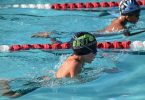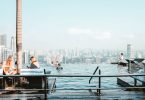A female swimmer body seems to defy the laws of nature, showing strength, agility, and a remarkable physique that many non-athletes females aspire to achieve.
So, what makes the female swimmer’s body so unique? Picture sleek, well-structured muscles, with a well-shaped back, strong shoulders, and toned arms that propel them through the water effortlessly.
The female swimmer’s body shows a pleasing blend of strength, power, and flexibility, proof of their intense training routine, schedule, and unwavering determination.
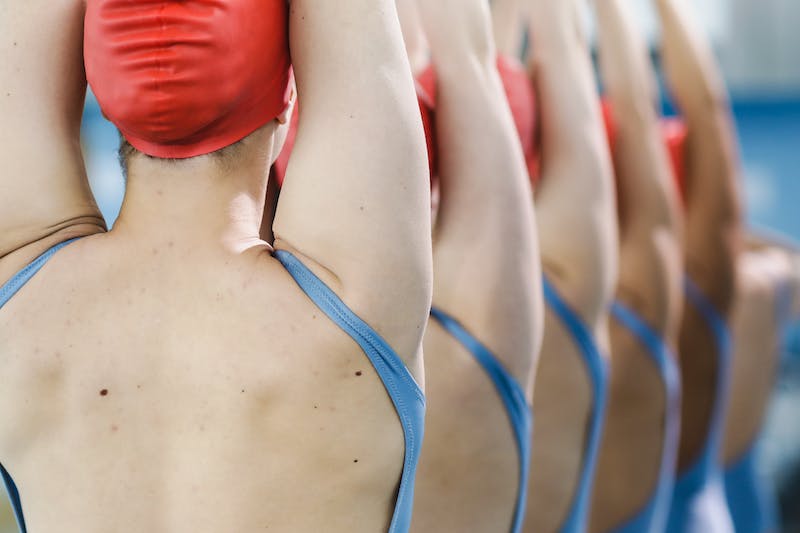
Have you ever wondered how they build those amazing athletic bodies? What hidden secrets lie behind their remarkable transformation from ordinary individuals to extraordinary athletes?
In this blog, we are about to reveal the secrets to achieving a fantastic female swimmer body.
Whether you’re an aspiring athlete, a fitness enthusiast, or simply curious about the secrets behind these incredible physiques, this guide is for you.
But first, let’s dismiss the notion that the female swimmer body is exclusive to professional athletes.
While some of these extraordinary women grace the world’s biggest stages, the path to a great female swimmer body is not restricted to the elite few.
Anyone with the desire and commitment can embark on this transformative journey, reaping the countless benefits along the way.
So, are you ready to embark on this transformative journey? Read on as we explore the secrets behind the amazing female swimmer’s body.
Table of Contents
1. Understand the Physiology of Female Swimmers
To truly excel in swimming as a female, it’s essential to understand how it impacts the female body differently than other sports.
We’ll explore the unique physiological aspects of female swimmers, including the muscle groups involved and their importance in achieving a great swimmer body.
How Swimming impacts the Female Body differently than other Sports
-
Low-impact, High-intensity: Unlike high-impact sports like running or basketball, swimming is a low-impact activity that provides an excellent cardiovascular workout without putting excessive strain on the joints.
This aspect is particularly beneficial for women, as it reduces the risk of injury while promoting long-term joint health. -
Enhanced Lung Capacity: Swimming requires controlled breathing techniques, allowing female swimmers to develop superior lung capacity.
By regularly engaging in breath control exercises, they can increase their lung volume and improve overall respiratory efficiency, contributing to better performance and endurance in the water.
Key Muscle Groups Involved and their Importance
-
Core Muscles: A strong core is vital for maintaining stability and efficient body positioning in the water.
Female swimmers rely on their core muscles, including the rectus abdominis, oblique muscle, and erector spinae, to generate power during strokes and stabilize their bodies for smooth and streamlined movement. -
Upper Body Strength: The upper body plays a crucial role in propelling swimmers through the water.
Female swimmers develop well-defined and strong muscles in the shoulders, back, and arms, including the deltoids, latissimus dorsi, trapezius, and biceps.
These muscles provide the necessary force for pulling through the water during strokes. -
Leg Power: While the upper body often receives more attention, leg strength is equally important for female swimmers.
Muscles such as the quadriceps, hamstrings, and calves contribute to kicking motions, providing propulsion and stability in the water.
Strong legs enable swimmers to maintain an efficient body position and generate powerful kicks for speed and acceleration.
Importance of the Muscle Groups
-
Injury Prevention: The strong core muscles developed by female swimmers protect the spine and reduce the risk of lower back injuries.
The well-trained upper body muscles help maintain proper shoulder alignment, preventing shoulder impingement and rotator cuff injuries.
Similarly, powerful leg muscles provide stability and prevent strains or imbalances during intense swimming sessions. -
Efficiency and Speed: The harmonious interplay of the core, upper body, and leg muscles allows female swimmers to move through the water with efficiency and speed.
Well-developed muscles in these areas generate greater power, resulting in improved stroke technique, enhanced propulsion, and ultimately faster swimming times.
-
Body Toning: Swimming not only strengthens muscles but also contributes to an overall toned physique.
Female swimmers often showcase well-defined arms, sculpted shoulders, and a toned core, highlighting the aesthetic benefits of the sport.
2. Eat good Nutrition or Diet for Optimal Performance
A balanced and nutritious diet is the fuel that powers your swimming performance.

Discover the specific nutritional requirements for female swimmers and learn about recommended food choices to support your body’s needs.
From macronutrients to hydration, we’ll cover it all to help you build that athletic female swimmer body, and maximize your potential in the pool.
Importance of a Balanced Diet for Female Swimmers
-
Enhanced Energy Levels: Fueling your body with the right nutrients ensures you have the energy to power through tough swimming sessions.
Carbohydrates are the primary energy source, so include complex carbohydrates like whole grains, fruits, and vegetables in your diet.
These foods provide a sustained release of energy, helping you maintain endurance during training and competitions. -
Muscle Development and Recovery: Swimming involves the use of various muscle groups, demanding strength and power. Adequate protein intake is essential for muscle development, repair, and recovery.
Include lean sources of protein such as chicken, fish, tofu, beans, and dairy products in your meals. Protein also aids in reducing muscle soreness and promoting faster recovery after intense training sessions. -
Optimal Hydration: Proper hydration is key for swimmers as they engage in intense physical activity in the water.
Dehydration can lead to decreased performance, fatigue, and muscle cramps.
Stay hydrated by consuming sufficient water throughout the day. Additionally, consume hydrating foods like watermelon, cucumber, and citrus fruits that contain high water content.
Nutritional Requirements and Recommended Food choices
-
Carbohydrates: Carbohydrates are the primary energy source for swimmers. Aim to include complex carbohydrates in your diet, such as whole grains (oats, brown rice), fruits (bananas, berries), and vegetables (sweet potatoes, broccoli).
These foods provide a steady release of energy and are rich in fiber, aiding digestion and overall health. -
Proteins: Protein is essential for muscle development, repair, and recovery. Incorporate lean sources of protein into your meals, such as skinless chicken, turkey, fish (salmon, tuna), eggs, legumes, and low-fat dairy products (Greek yogurt, cottage cheese).
Protein-rich snacks like almonds and protein bars can also be beneficial. -
Healthy Fats: Contrary to popular belief, fats are an important component of a balanced diet. Opt for healthy fats like avocados, nuts (almonds, walnuts), seeds (chia seeds, flaxseeds), and fatty fish (salmon, mackerel).
These fats provide essential fatty acids, promote brain health, and support joint mobility. -
Vitamins and Minerals: Aim for a colorful plate to ensure you consume a variety of vitamins and minerals necessary for overall health and performance.
Include a variety of fruits, vegetables, and leafy greens in your diet. Additionally, consider a high-quality multivitamin or consult with a healthcare professional to address any specific nutritional deficiencies. -
Timing and Pre/Post-Workout Nutrition: Pay attention to your meal timing and pre/post-workout nutrition. Consume a balanced meal or snack 2-3 hours before training or competition to provide sustained energy.
Opt for easily digestible foods that contain carbohydrates and a moderate amount of protein.
After a workout, replenish your glycogen stores and aid muscle recovery by consuming a snack or meal within 30-60 minutes, containing a mix of carbohydrates and protein.
READ ALSO: How to set an alarm for 7:50 AM swimming class and its Benefits
3. Practice Effective Strength Training Exercises
Strength training is a game-changer when it comes to building a strong female swimmer body.
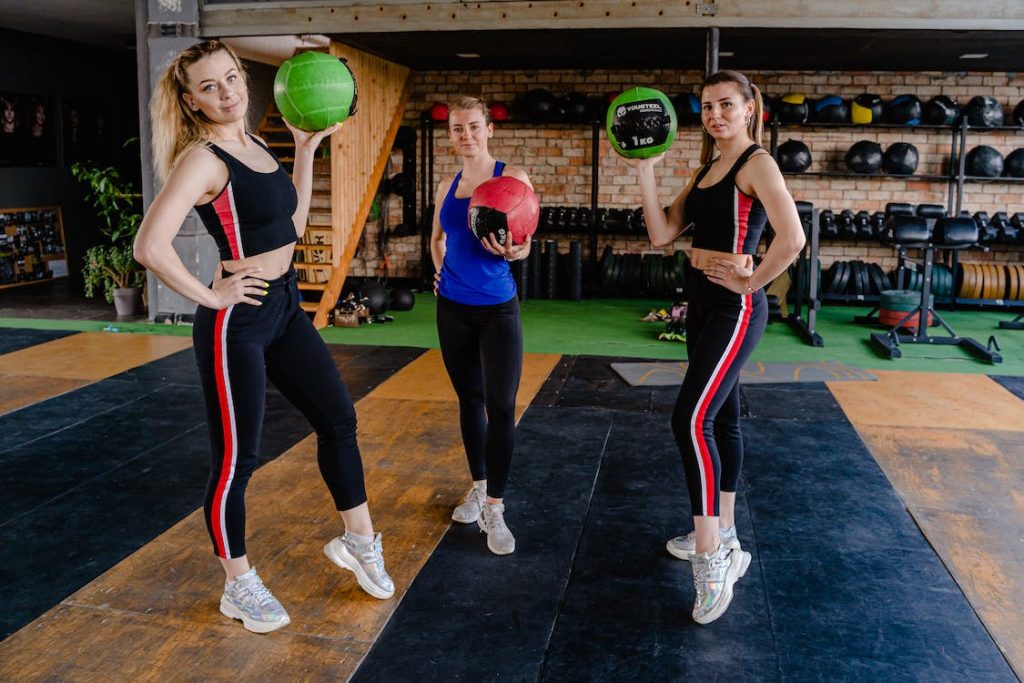
We’ll share a variety of targeted exercises that focus on the muscle groups crucial for building that perfect female swimmer body for swimming.
Get ready to dive into a comprehensive workout routine designed to enhance your swimming performance and boost your overall strength.
Why Strength Training Matters for Female Swimmers
- Injury Prevention: Strengthening the muscles around your joints can help prevent common swimming-related injuries, such as shoulder impingement or lower back strain.
- Increased Power and Efficiency: Stronger muscles allow swimmers to generate more power with each stroke, resulting in improved propulsion and increased swimming efficiency.
- Enhanced Endurance: Strengthening specific muscle groups used in swimming can delay the onset of fatigue, enabling swimmers to swim longer distances without compromising form.
- Improved Core Stability: A strong core is essential for maintaining proper body position and stability in the water, leading to improved overall performance.
Targeting Specific Muscle Groups used in Swimming
- Latissimus Dorsi (Lats): The lats are responsible for the pulling motion during swimming. Exercises like lat pulldowns, bent-over rows, and pull-ups can effectively target and strengthen these muscles.
- Deltoids: The deltoids contribute to the power and stability of the shoulder joint. Shoulder presses, lateral raises, and front raises can help develop strong deltoid muscles.
- Pectorals (Chest Muscles): Chest muscles play a significant role in the initial phase of the swimming stroke. Push-ups, bench presses, and chest fly exercises can strengthen the pectorals.
- Quadriceps and Hamstrings: These muscle groups are crucial for generating powerful kicks in swimming. Squats, lunges, and leg press exercises can target and strengthen the quads and hamstrings.
- Core Muscles: A strong core improves body stability and rotation in the water. Planks, Russian twists, and flutter kicks are effective exercises for strengthening the core.
Recommended Strength Training Exercises for Female swimmers
- Lat Pulldowns: This exercise targets the lats and helps build upper body strength. Use a lat pulldown machine and perform three sets of 8-12 reps.
- Shoulder Press: Strengthen your deltoids with a dumbbell or barbell shoulder presses. Aim for three sets of 10-15 reps.
- Push-ups: A classic exercise that targets the chest, triceps, and core muscles. Start with three sets of 10 reps and gradually increase intensity.
- Squats: Build lower body strength by performing squats with or without weights. Aim for three sets of 12-15 reps.
- Planks: Strengthen your core with forearm planks. Hold the position for 30-60 seconds and gradually increase the duration over time.
Remember, consistency is key when it comes to strength training. Start with lighter weights or bodyweight exercises and gradually increase the intensity as you progress.
It’s also important to maintain proper form and technique throughout each exercise to maximize effectiveness and minimize the risk of injury.
4. Building Endurance in the Pool
Endurance is one of the secret ingredient to swimming success and building good a perfect female swimmer body. We’ll explore training techniques specifically tailored to improve your endurance levels in the water.
From interval training to distance swims, you’ll discover effective strategies to increase your stamina and swim longer, faster, and stronger.
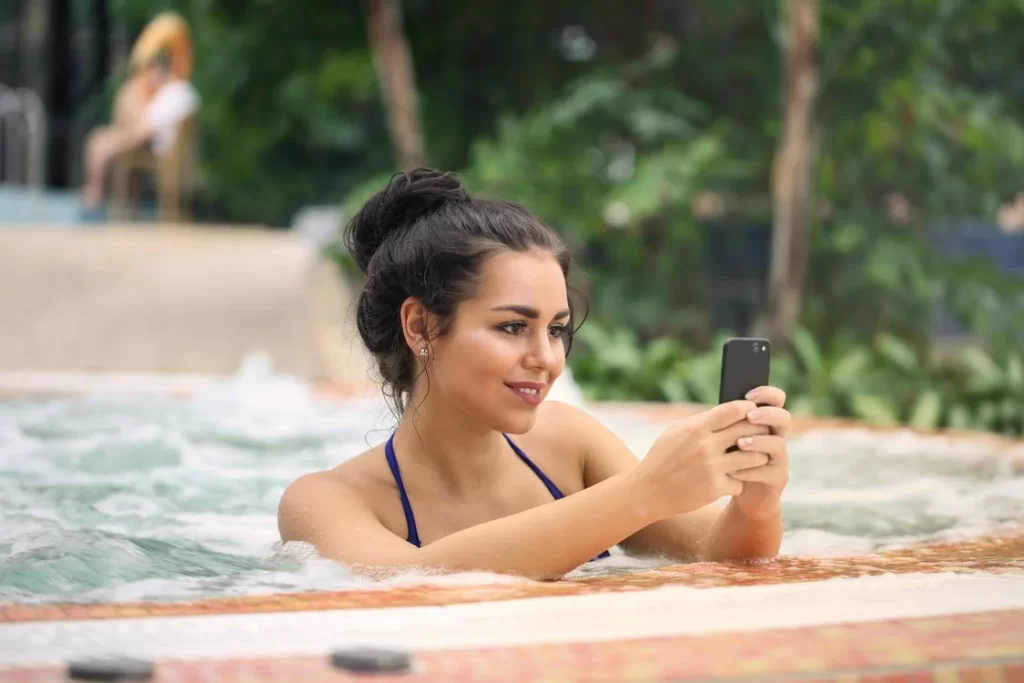
Before we dive into the training techniques, let’s take a moment to understand what endurance truly means in the context of swimming:
Endurance refers to the ability to sustain prolonged physical exertion without experiencing fatigue.
In swimming, endurance translates to the capacity to maintain a steady pace for an extended period, allowing you to cover more distance and improve overall performance when swimming.
Training Techniques to Improve Endurance
-
Consistent Training Schedule: Establishing a consistent training schedule is essential when aiming to build endurance.
Regularly dedicating time to swimming will allow your body to adapt and gradually increase its capacity to withstand prolonged periods of exertion. -
Progressive Distance Swims: Incorporating distance swims into your training regimen is an effective way to build endurance.
Start by setting achievable goals and gradually increase the distance as you become more comfortable.
This progressive approach challenges your body to adapt to longer periods of sustained effort, pushing your endurance limits. -
Interval Training: Interval training involves alternating between high-intensity bursts and recovery periods.
It is an excellent technique for improving endurance as it simulates the fluctuating demands of competitive swimming.
By pushing your limits during the high-intensity intervals and allowing yourself to recover during the rest periods, your body becomes more efficient at clearing lactic acid and increasing aerobic capacity. -
Fartlek Training: Fartlek training, a form of interval training, combines speed and endurance. This technique involves varying your swimming speed and intensity throughout a workout.
By incorporating fast sprints and slower recovery laps, you challenge different energy systems, promoting improved endurance and overall speed. -
Pyramid Sets: Pyramid sets are a structured training method that involves progressively increasing and then decreasing the distance swum in a workout.
For example, start with shorter distances and gradually increase the distance with each set until reaching a peak, then decrease the distances in a reverse pattern.
This technique helps build both mental and physical endurance by challenging your body to adapt to increasing and decreasing levels of exertion.
Additional Tips for Building Endurance
-
Breathing Techniques: Efficient breathing plays a crucial role in building endurance. Focus on maintaining a steady and controlled breathing pattern, exhaling fully underwater, and taking quick, efficient breaths during recovery.
Proper breathing techniques maximize oxygen intake, reducing fatigue and enabling you to swim for longer durations. -
Proper Technique and Body Position: Efficient swimming technique and body position are essential for conserving energy and maintaining stamina.
Streamlining your body, reducing drag, and ensuring proper body alignment in the water will minimize energy expenditure and enable you to swim more efficiently. -
Strength and Conditioning: Strength training exercises that target the muscles used in swimming can greatly contribute to building endurance.
Take on exercises that focus on the core, upper body, and lower body strength to enhance your swimming performance and improve overall stamina.
5. Perfecting Your Technique
Even the fittest swimmers can struggle without proper technique. We’ll unveil key swimming techniques that enhance efficiency and speed, which in the process build the female swimmer body you want.

Together, we will dive into the essential details of the different swim strokes, body positioning, and breathing techniques, while also learning about common mistakes to avoid and tips for continuous improvement.
Key Swimming Techniques for Efficiency and Speed
- Freestyle (Front Crawl) Technique: Freestyle, also known as front crawl, is the most common and efficient swimming stroke. To perfect your freestyle technique, focus on the following elements:
- Body Position: Maintain a horizontal body position by keeping your head aligned with your spine. Avoid lifting your head too high, as it can cause your hips and legs to sink, increasing drag.
- Arm Stroke: Begin the stroke by extending one arm forward, entering the water with a slightly angled hand. As you pull your arm back, keep it close to your body and accelerate through the water, finishing with a strong push.
- Leg Kick: Execute a steady and continuous flutter kick from your hips, keeping your legs straight and your feet relaxed. Avoid excessive knee bending or scissor kicks, as they can slow you down.
- Breathing Technique: Breathe rhythmically by turning your head to the side during the recovery phase of your arm stroke. Exhale gradually underwater and inhale quickly when your mouth clears the surface.
- Backstroke Technique: Backstroke is a fantastic stroke for improving balance, coordination, and building strength in your back muscles. Follow these tips to enhance your backstroke technique:
- Body Position: Keep your body in a horizontal position with your face towards the sky. Maintain a relaxed neck and arch your back slightly.
- Arm Stroke: Start with your arms extended straight above your head. Pull one arm down towards your hip while the other arm recovers above the water. Maintain a constant and steady arm movement throughout the stroke.
- Leg Kick: Execute a flutter kick with your legs, similar to the freestyle technique. Maintain a steady and symmetrical motion, keeping your knees relatively straight and your feet relaxed.
- Breathing Technique: Breathe by rotating your head to the side when your arm is recovering above the water. Ensure that your mouth is clear of the water before inhaling.
- Breaststroke Technique: Breaststroke is a graceful and powerful stroke that requires coordination between the upper and lower body. Follow these guidelines to improve your breaststroke technique:
- Body Position: Begin in a streamlined position, with your body extended and your face in the water. During the stroke, your head should lift to breathe, but avoid lifting it too high, as it can slow you down.
- Arm Stroke: Initiate the stroke by pulling your arms simultaneously in a circular motion, sweeping outwards and then inward towards your chest. Extend your arms forward, keeping them parallel to the water’s surface.
- Leg Kick: Perform a frog kick by bending your knees and drawing your feet towards your buttocks. Push your feet outwards, extend your legs, and bring them together in a powerful snap before repeating the motion.
- Breathing Technique: Coordinate your breath with your arm stroke. Breathe in during the recovery phase, just before your arms begin the pull phase.
Common Mistakes to Avoid and Tips for Improvement
- Overreaching: Avoid extending your arms too far during each stroke, as it increases resistance and slows you down. Focus on a shorter, more efficient arm extension to maintain a smooth rhythm.
- Incorrect Breathing: Many swimmers tend to hold their breath or exhale too forcefully underwater, leading to inefficient oxygen intake. Remember to exhale gradually underwater and inhale quickly when your mouth clears the surface.
- Weak Kicks: Neglecting the power and rhythm of your leg kicks can hinder your overall speed. Practice leg exercises to strengthen your kick and maintain a consistent motion.
- Poor Body Position: Keeping your body aligned and horizontal is crucial for minimizing drag. Avoid lifting your head too high or sinking your hips and legs, as it increases resistance.
- Lack of Consistency: Consistent practice is essential for perfecting your swimming technique. Incorporate drills and structured training sessions to reinforce proper form and muscle memory.
READ ALSO: 10 important things you need to know about western zone swimming
6. Practice the Role of Cross-Training in Swimming
Cross-training activities can complement and elevate your swimming performance.
We’ll highlight the benefits of cross-training for female swimmers and provide examples of activities that can enhance your overall strength, flexibility, and cardiovascular fitness.
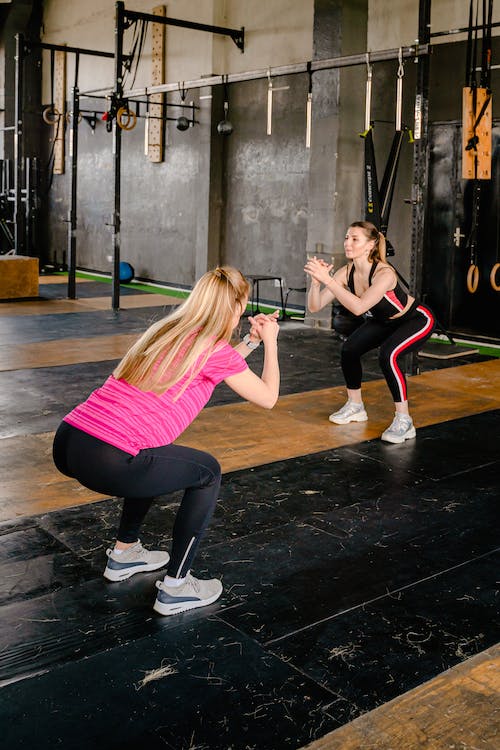
Discover how incorporating cross-training into your routine can build your female swimmer body and also take your body shape to new heights.
Benefits of Cross-Training for Female Swimmers
-
Injury Prevention: One of the key advantages of cross-training is its ability to prevent injuries.
Swimming is a repetitive sport that places a considerable strain on specific muscle groups. Engaging in cross-training activities helps to balance the muscular load and reduces the risk of overuse injuries.
By incorporating different exercises, swimmers can strengthen their entire body, including core muscles, arms, legs, and even their stabilizing muscles.
This overall body conditioning contributes to better posture, flexibility, and joint stability, ensuring a safer and more sustainable swimming experience.
-
Improved Cardiovascular Fitness: Cross-training activities that involve aerobic exercises like running, cycling, or even dance classes, can significantly enhance a swimmer’s cardiovascular fitness.
These activities increase heart rate, improve lung capacity, and enhance endurance levels, which are crucial for sustained performance in the water.
The combination of swimming and cross-training exercises strengthens the heart and lungs, allowing female swimmers to swim longer and with greater efficiency. -
Enhanced Strength and Power: Cross-training activities provide an opportunity to target muscle groups that swimming alone may not fully engage.
Strength training exercises, such as weightlifting, resistance training, or bodyweight exercises, help build muscular strength and power.
A stronger core and upper body strength, for instance, can improve stroke technique and propulsion in the water.
By incorporating cross-training, female swimmers can develop a more balanced physique, reducing muscle imbalances and enhancing their overall swimming performance. -
Mental Refreshment: Swimming is a mentally demanding sport that requires focus, discipline, and perseverance.
Engaging in cross-training activities offers a refreshing break from the boredom, dullness, and stress of the pool and provides a mental reset.
Cross-training can help alleviate the mental fatigue associated with swimming, keeping swimmers motivated and restored.
Whether it’s yoga, Pilates, or other mindful exercises, these activities promote mental clarity, relaxation, and overall well-being, all of which positively impact swimming performance.
Examples of Cross-Training Activities to Enhance Performance
-
Yoga and Pilates: Yoga and Pilates are excellent cross-training activities for female swimmers.
These low-impact exercises improve flexibility, balance, and core strength, which are essential for optimal swimming performance.
Yoga and Pilates also promote mindfulness, stress reduction, and body awareness, enabling swimmers to fine-tune their technique and achieve better overall control in the water. -
Strength Training: Incorporating strength training exercises into a swimmer’s routine can be highly beneficial.
Weightlifting, resistance band workouts, or bodyweight exercises like push-ups and pull-ups help build muscle strength and power.
Focusing on specific muscle groups, such as the shoulders, back, and core, can enhance stroke technique, stability, and overall swimming efficiency. -
Cycling and Running: Aerobic activities like cycling and running improve cardiovascular fitness, stamina, and endurance.
These exercises increase lung capacity, strengthen leg muscles, and promote overall fitness.
Engaging in cycling or running sessions alongside swimming workouts can have a synergistic effect, enhancing overall physical conditioning and performance. -
CrossFit and HIIT Workouts: For those seeking a high-intensity challenge, CrossFit and HIIT (High-Intensity Interval Training) workouts provide an excellent option.
These workouts incorporate a combination of cardiovascular exercises, strength training, and functional movements.
The intense nature of these workouts helps improve cardiovascular endurance, explosive power, and overall athletic performance, complementing the demands of competitive swimming.
7. Mental Preparation and Visualization
Swimming is as much a mental game as it is a physical one. We’ll delve into the importance of mental strength for swimmers and share techniques for mental preparation and visualization exercises.
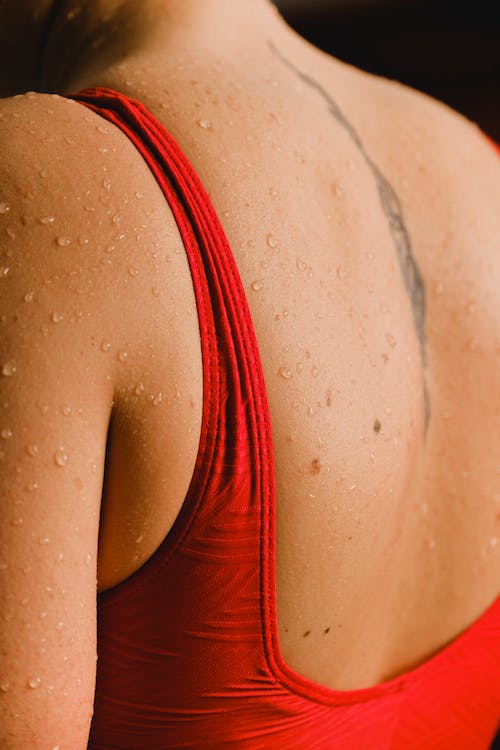
Learn how to overcome pre-race nervousness, stay focused during training, and harness the power of your mind to unlock your full potential in the water.
Importance of Mental Strength in Swimming
Mental strength plays a crucial role in swimming as it directly impacts an athlete’s performance, consistency, and ability to overcome challenges.
Here are several key reasons why mental strength is vital in the world of swimming:
-
Confidence Boost: A strong mental game enhances an athlete’s confidence, allowing them to believe in their abilities and push beyond their limits.
When swimmers possess unwavering confidence, they can approach races with a winning mindset.
-
Focus and Concentration: Swimming requires intense concentration and focus to maintain proper technique, pacing, and race strategies.
Mental strength helps swimmers tune out distractions and stay focused on their goals, resulting in improved performance. -
Stress Management: Competitive swimming can be mentally and emotionally demanding.
Mental strength equips swimmers with effective stress management techniques, enabling them to handle pressure situations, such as important races or qualifying events, with composure. -
Resilience and Adaptability: Swimming often presents unexpected challenges, such as equipment malfunctions, adverse weather conditions, or tough competition.
Mental strength helps swimmers bounce back from setbacks, adapt to changing circumstances, and maintain a positive mindset throughout their journey.
Techniques for Mental Preparation and Visualization Exercises
Now that we understand the importance of mental strength in swimming, let’s explore some effective techniques for mental preparation and visualization exercises that can elevate your performance in the pool:
-
Goal Setting: Set clear and realistic goals for your swimming journey. Define both short-term and long-term objectives, focusing on specific aspects you want to improve.
Having goals in mind gives your mental preparation a sense of direction and purpose.
-
Positive Self-Talk: Develop a habit of positive self-talk to cultivate a confident and resilient mindset. Replace negative thoughts with empowering affirmations.
Remind yourself of your strengths, past achievements, and the hard work you’ve put into your training. -
Mental Rehearsal and Visualization: Visualization is a powerful technique where you mentally rehearse your races, focusing on every detail of your performance.
Visualize yourself executing flawless strokes, maintaining perfect form, and reaching the finish line triumphantly. Engage all your senses to make the experience more vivid and compelling.
-
Breathing and Relaxation Techniques: Deep breathing exercises and relaxation techniques can help calm your mind and body before races or intense training sessions.
Practice controlled breathing to reduce anxiety, promote focus, and maintain a steady rhythm while swimming. -
Mindfulness and Meditation: Incorporate mindfulness and meditation into your daily routine. These practices enhance self-awareness, improve mental clarity, and enable you to be present in the moment.
They also help you manage stress and maintain a calm state of mind. -
Mental Imagery: Besides visualizing races, mental imagery involves imagining various scenarios and how you would respond to them.
This technique prepares you for unexpected situations and builds confidence in your ability to handle any challenges that arise during competitions.
READ ALSO: History of open water swimming in Australia
8. Injury Prevention and Recovery
To achieve a great female swimmer body, it’s crucial to prioritize injury prevention and recovery.
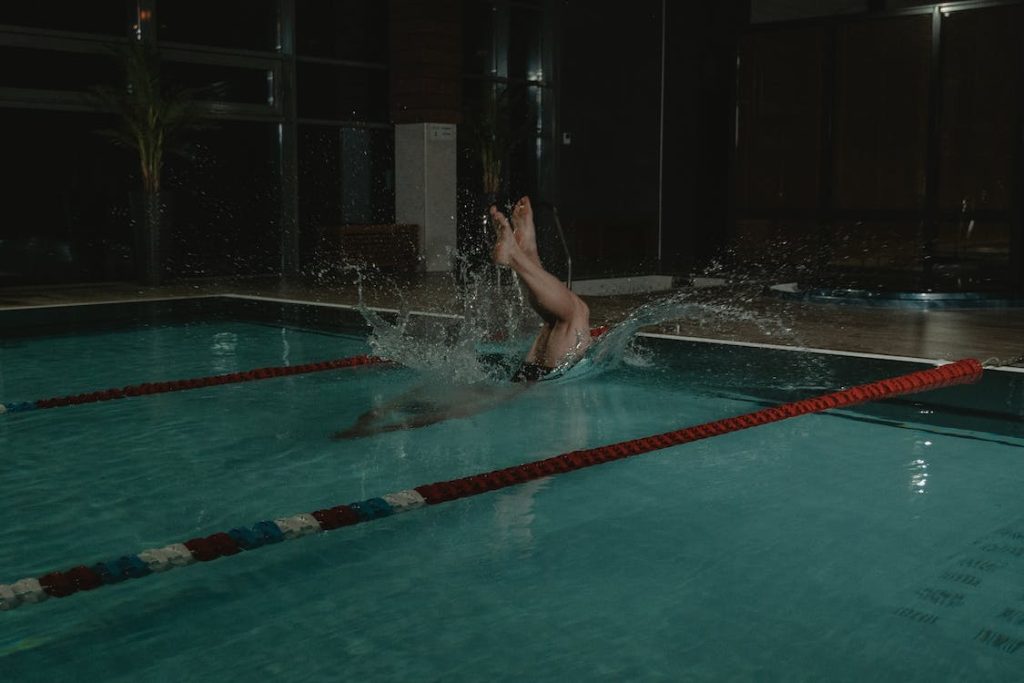
We’ll explore common swimming injuries among female swimmers and provide strategies to prevent and rehabilitate them.
Discover how to incorporate proper warm-up and cool-down exercises, along with stretching techniques, into your routine to minimize the risk of injuries and ensure a speedy recovery.
Common Swimming Injuries among Female Swimmers
-
Shoulder Impingement Syndrome: One of the most prevalent injuries among female swimmers is shoulder impingement syndrome.
The repetitive overhead movements involved in swimming can lead to inflammation and compression of the rotator cuff tendons. This condition often results in pain, reduced range of motion, and shoulder weakness.
Strengthening the muscles surrounding the shoulder joint and incorporating proper stroke techniques can help prevent this injury. -
Swimmer’s Knee (Patellofemoral Pain Syndrome): Swimmer’s knee, or patellofemoral pain syndrome, manifests as pain around the kneecap. It occurs due to improper knee alignment during the kicking motion, leading to excessive stress on the joint.
Engaging in strengthening exercises for the quadriceps and hip muscles, along with improving technique and using appropriate equipment, can aid in preventing this condition. -
Lower Back Pain: The repetitive undulation of the spine during swimming can put a strain on the lower back, resulting in discomfort and pain. Weak core muscles and poor body alignment exacerbate this issue.
Core-strengthening exercises, such as planks and bridges, as well as maintaining proper body alignment during strokes, are essential in preventing lower back pain.
Strategies for Injury Prevention and Rehabilitation
-
Warm-up and Stretching: Before swimming, engaging in a dynamic warm-up routine helps increase blood flow to the muscles and prepares them for the demands of the activity.
Incorporating dynamic stretches targeting the major muscle groups involved in swimming, such as the shoulders, hips, and legs, can enhance flexibility and reduce the risk of injury. -
Cross-Training: Participating in cross-training activities, such as yoga, Pilates, or strength training, can provide swimmers with a well-rounded fitness regimen.
These activities help strengthen muscles that are not heavily used in swimming, improving overall muscle balance and reducing the likelihood of overuse injuries.
-
Technique Improvement: Proper technique plays a pivotal role in injury prevention. Working with a qualified swimming coach who can assess your stroke mechanics and provide guidance for improvement is highly beneficial.
Focusing on maintaining correct body alignment, reducing drag, and using efficient movements can minimize stress on vulnerable areas and decrease the risk of injury. -
Gradual Progression and Rest: Gradually increasing training intensity and volume allows the body to adapt to the demands of swimming, reducing the risk of overuse injuries.
Additionally, incorporating rest days into your training schedule provides vital recovery time, allowing the body to repair and strengthen itself. -
Rehabilitation and Recovery: In the unfortunate event of an injury, it is crucial to seek professional medical advice for diagnosis and treatment.
Following a comprehensive rehabilitation program, including physical therapy and targeted exercises, can help restore strength, mobility, and flexibility.
Patience and adherence to the prescribed recovery plan are essential for a successful return to swimming.
9. Use the Proper Swim Gear and Equipment for Swimming
The right swim gear can make a significant difference in your swimming performance.
From swimwear to goggles and accessories, we’ll guide you through choosing the best equipment for your needs.
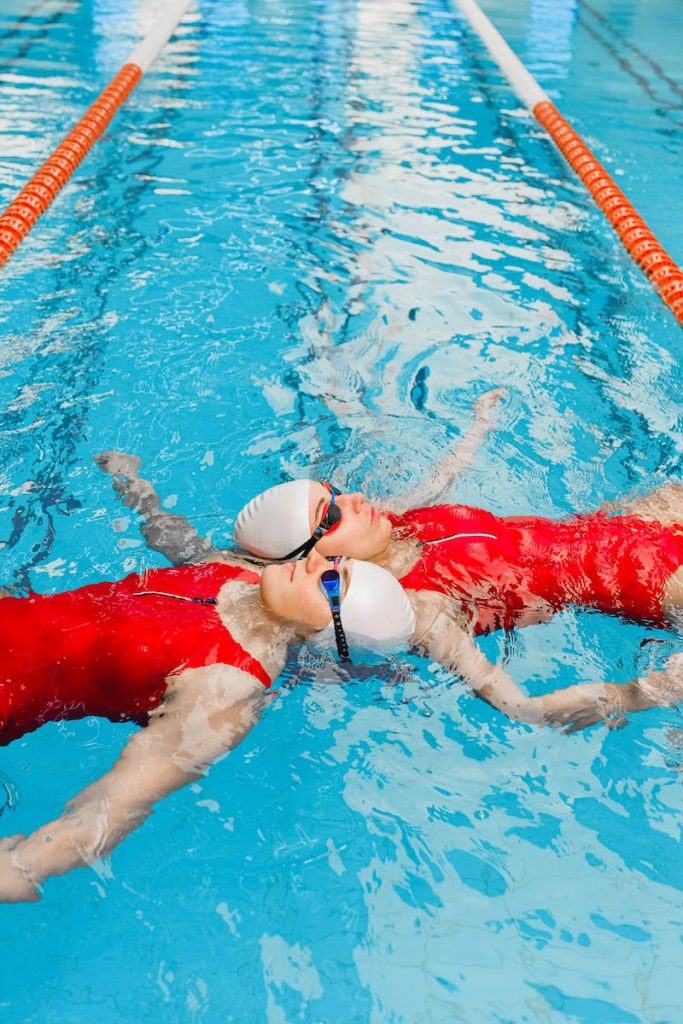
Explore the latest advancements in swim gear technology and find out how the right gear can enhance your comfort, speed, and overall swimming experience.
Essential Swim Gear for Female Swimmers
- Swimwear: This is a special wear, or clothing for swimmers for comfortable movement while swimming. There are different types of swimwear and they are listed below:
-
One-Piece Swimsuits: Offering excellent coverage and support, one-piece swimsuits are a popular choice for female swimmers. They provide comfort and freedom of movement while ensuring modesty.
-
Two-Piece Swimsuits: Two-piece swimsuits offer more flexibility and are a preferred option for recreational swimmers.
They come in various styles, such as tankinis and bikinis, allowing you to find the right fit for your body type and personal preference. -
Training Swimwear: For competitive swimmers, training swimwear is designed to minimize drag and maximize performance.
These wear are made of durable materials that provide compression and reduce water resistance.
-
Swim Goggles: Swim goggles are a type of eyewear specifically designed for swimming. They are worn over the eyes to protect them from water and provide clear vision underwater.
Swim goggles come in various shapes, sizes, and styles to accommodate different preferences and swimming activities. Below are what to consider when getting a goggle.
- Fit and Comfort: When choosing goggles, it’s crucial to find a pair that fits securely and comfortably around your eyes. Look for adjustable straps and soft seals to prevent water leakage and minimize eye irritation.
- Lens Type: Goggle lenses come in different colors and tints. Clear lenses offer good visibility in indoor pools, while tinted lenses are ideal for outdoor swimming, reducing glare and providing UV protection.
- Anti-Fog Coating: Opt for goggles with an anti-fog coating to maintain clear vision throughout your swim. This feature helps prevent condensation on the lens, ensuring a fog-free experience.
3. Additional Swim Accessories: Swim accessories are items or equipment used by swimmers to enhance their swimming experience, improve performance, ensure safety, or provide comfort in the water. Some common swim accessories include:
-
Swim Caps: Swim caps are essential for keeping your hair under control and reducing drag in the water. Silicone caps offer durability and a secure fit, while latex caps provide a more lightweight option.
- Ear Plugs: Protect your ears from water and potential infections with ear plugs. Look for comfortable, waterproof plugs that effectively keep water out without compromising hearing.
- Nose Clips: If you struggle with water entering your nose while swimming, consider using nose clips.
These small accessories help keep water out, allowing you to focus on your strokes and breathing.
How to Choose the Right Swim Gear
- Consider Your Purpose: Determine whether you are swimming for leisure, fitness, or competition. This will help you select gear that aligns with your specific goals and requirements.
-
Body Type and Comfort: Choose swimwear that complements your body shape and offers a comfortable fit.
Consider your range of motion in the water and select goggles and accessories that enhance your overall comfort.
- Quality and Durability: Invest in swim gear that is made of high-quality materials. Look for reputable brands that offer durability and longevity, ensuring that your gear withstands regular use and exposure to chlorine and saltwater.
- Personal Style: While functionality is important, there’s no harm in embracing your personal style. Select swim gear in colors and designs that make you feel confident and motivated to hit the pool.
READ ALSO: 7 Swimming Techniques That Will Save Your Life
10. Take part in Pre and Post-Swim Care
Proper pre and post-swim care is often overlooked but essential for maintaining a great swimmer body.
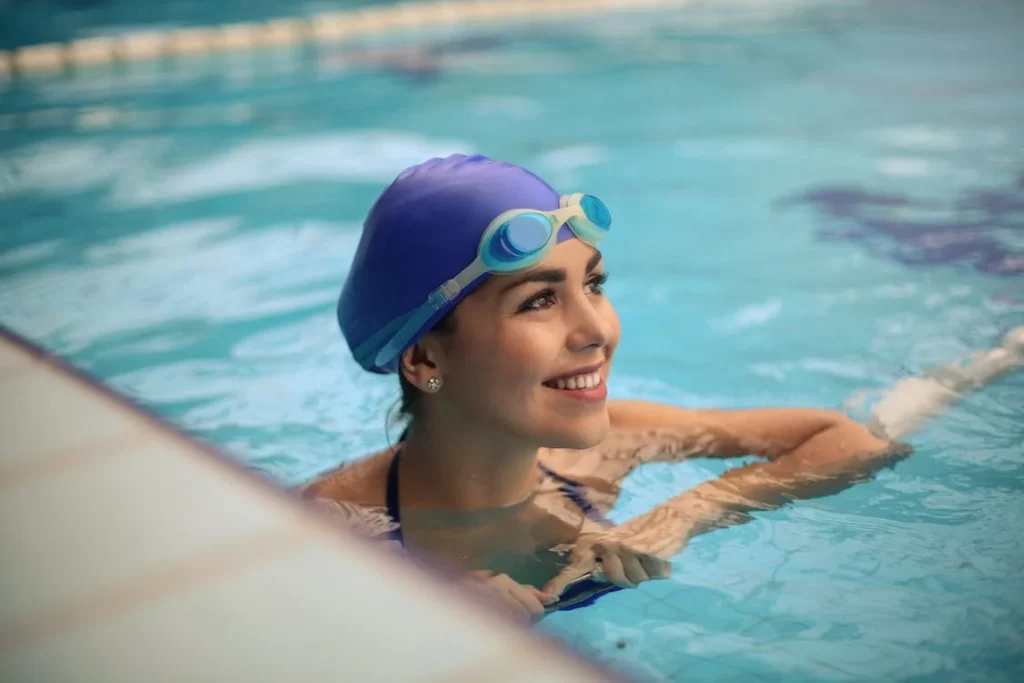
Discover effective warm-up and cool-down exercises specifically designed for swimmers.
Learn stretching techniques to prevent muscle soreness and ensure your body is primed for optimal performance in the pool.
Conclusion
In conclusion, achieving a great female swimmer body is a combination of dedication, discipline, and a holistic approach to training.
By understanding the unique physiological aspects of female swimmers, fueling your body with the right nutrition, incorporating strength training and endurance-building exercises, perfecting your technique, and nurturing your mental well-being, you’ll be well on your way to unlocking your full potential in the pool.
Remember, each swimmer’s journey is unique, and progress may come at different paces. Embrace the process, stay committed, and enjoy the transformative power of swimming.
Dive into these secrets, apply them to your training routine, and watch as your body and performance reach new heights.
Your journey begins now. Let the water be your canvas, and your body the masterpiece. Happy swimming!


